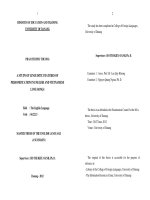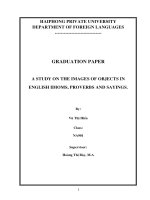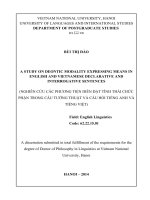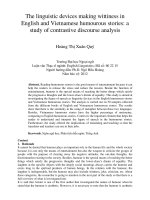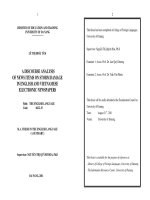A study on linguistic features of headlines in english and vietnamese electronic newspapers
Bạn đang xem bản rút gọn của tài liệu. Xem và tải ngay bản đầy đủ của tài liệu tại đây (1.58 MB, 120 trang )
MINISTRY OF EDUCATION AND TRAINING
HANOI OPEN UNIVERSITY
LÝ KIỀU HẠNH
A STUDY ON LINGUISTIC FEATURES OF HEADLINES IN
ENGLISH AND VIETNAMESE ELECTRONIC NEWSPAPERS
(NGHIÊN CỨU VỀ ĐẶC ĐIỂM NGÔN NGỮ CỦA TIÊU ĐỀ TIẾNG
ANH VÀ TIẾNG VIỆT TRÊN BÁO ĐIỆN TỬ)
M.A. THESIS
Field: English Language
Code: 60220201
Hanoi, 2016
MINISTRY OF EDUCATION AND TRAINING
HANOI OPEN UNIVERSITY
LY KIEU HANH
A STUDY ON LINGUISTIC FEATURES OF HEADLINES IN
ENGLISH AND VIETNAMESE ELECTRONIC NEWSPAPERS
(NGHIÊN CỨU VỀ ĐẶC ĐIỂM NGÔN NGỮ CỦA TIÊU ĐỀ TIẾNG
ANH VÀ TIẾNG VIỆT TRÊN BÁO ĐIỆN TỬ)
M.A. THESIS
Field: English Language
Code: 60220201
Supervisor: Dr. Nguyễn Thị Vân Đông
Hanoi, 2016
CERTIFICATE OF ORIGINALITY
I, the undersigned, hereby certify my authority of the study project
report entitled “A study on linguistic features of headlines in English
and Vietnamese electronic newspapers” submitted in partial fulfillment
of the requirements for the degree of Master in English Language. Except
where the reference is indicated, no other person’s work has been used
without due acknowledgement in the text of the thesis.
Hanoi, 2016
Ly Kieu Hanh
Approved by
SUPERVISOR
Dr.Nguyen Thi Van Dong
(Signature and full name)
Date: October, 2016
i
ACKNOWLEDGEMENTS
For the completion of this work, I have been fortunate to receive
invaluable contribution from many people. First of all, I would like to
express my deepest gratitude to my supervisor Dr. Nguyen Thi Van Dong
for her useful advice and encouragement while I was working on the
thesis.
I would also like to express my sincere thanks to all my teachers in
M.A course at the Faculty of Graduate studies, Hanoi Open University, for
their useful lectures, advice and suggestions.
Finally, I wish to express my deepest gratitude to my family for their
love, encouragement and support. Without this, the completion of this
study would be impossible.
ii
ABSTRACT
This thesis is an attempt to deal with the linguistic features of headlines
in English and Vietnamese electronic newspapers.
To fulfill this objective, the study makes great effort to point out some
similarities and differences between the use of linguistic features of
headlines in English and Vietnamese electronic newspapers. The research
is not concerned with all the aspects of linguistic features. Since the
investigation is just carried out in linguistic features, syntactic and
semantic features of headlines in English and Vietnamese electronic
newspapers are taken into consideration. From the analysis, syntactic and
semantic features of English and Vietnamese headlines are identified and
explained.
Based on the findings, the thesis provides some implications for
translators and linguistics to do research on linguistics especially in
syntactic and semantic features and gives some suggestions for further
research.
Criticism and comments are welcome for more profession of the thesis.
iii
LIST OF ABBREVIATIONS
EHs.:
English headlines
VHs.:
Vietnamese headlines
iv
LIST OF TABLES AND FIGURES
Figure 2.1: Logos and name of some prestigious English online
newspapers
17
Figure 2.2: Logos and name of some famous Vietnamese online
newspapers
18
Table 3.1. List of typical English headlines on electronic newspapers
Table 3.2. List of typical English headlines on electronic newspapers
Table 4.1 The frequency and percentage of syntactic use in EHs and
VHs
38
Table 4.2 The frequency of appearance of semantic features in EHs
40
Table 4.3: The frequency of appearance of semantic features in VHs
47
Table 4.4: Comparison of semantic features frequency in EHs and 54
VHs
v
TABLE OF CONTENTS
Certificate of originality
i
Acknowledgements
ii
Abstract
iii
List of abbreviations
iv
List of tables and figures
v
Chapter 1: INTRODUCTION ...................................................................... 1
1. Rationale ................................................................................................ 1
2. Aims of the Study: ................................................................................ 2
3. Objectives of the study ......................................................................... 3
4. Scope of the Study................................................................................ 3
5. Significance of the study ..................................................................... 4
6. Organization of the Study .................................................................... 4
Chapter 2 – LITERATURE REVIEW ......................................................... 6
2.1 Review of previous studies ............................................................... 6
2.2 Review of theoretical background...................................................... 7
2.2.1. Theoretical framework ............................................................... 7
2.2.2 Types of meaning ...................................................................... 11
2.2.2.1. Denotation meaning .............................................................. 11
2.2.2.2 Connotation meaning ............................................................. 12
2.2.2.3 Stylistic devices ...................................................................... 13
2.2.3. Theoretical background ............................................................ 17
2.2.3.1 Electronic Newspapers ........................................................... 17
2.2.3.2 What is meant by Headlines? ................................................. 20
2.2.3.3. Functions of Headlines .......................................................... 22
2.2.3.4 The role of headlines. ............................................................. 23
2.2.3.5. The Language of Headlines................................................... 24
2.3 Summary ........................................................................................ 29
Chapter 3: METHODOLOGY .................................................................. 30
vi
3.1. Research-governing orientations ................................................... 30
3.1.1. Research questions .................................................................. 30
3.1.2. Research setting ....................................................................... 30
3.1.3. Research approach(es) ............................................................. 31
3.1.4. Principles/criteria for intended data collection and data analysis . 32
3.2. Research methods .......................................................................... 33
3.2.1. Major methods vs. supporting methods .................................. 33
3.2.2. Data collection techniques....................................................... 34
3.2.3. Data analysis techniques ......................................................... 35
3.3. Summary ..................................................................................... 35
CHAPTER IV: FINDINGS AND DISCUSSION ..................................... 37
4.1 Syntactic features of headlines in English and Vietnamese
electronic newspapers............................................................................. 37
4.1.1Syntactic features of headlines in English electronic newspapers... 37
4.1.2 Syntactic features of headlines in Vienamese electronic
newspapers. ........................................................................................ 40
4.2 Semantic features of headlines in English and Vietnamese electronic
newspapers. ............................................................................................ 45
4.2.1. Semantic features of headlines in English. .............................. 45
4.2.2 Semantic features of headlines in Vietnamese ........................ 53
4.2.3 The similarities and differences between the use of semantic
features in English and Vietnamese headlines ................................... 61
4.3 Implication........................................................................................ 63
4.4. Summary ......................................................................................... 64
CHAPTER V: CONCLUSION .................................................................. 66
5.1. Recapitulation ................................................................................ 66
5.2 Concluding remarks (on each of the thesis objectives).................... 66
5.3 Limitations of the current research................................................... 67
5.4. Suggestions for further research ...................................................... 68
REFERENCES ........................................................................................... 70
APPENDICES
vii
Chapter 1: INTRODUCTION
1. Rationale
The press, one form of the media which has long become a means of
communication, has an important role as well as a potential power in our
society. It has an important role in human’s life since it gives people
information about the surrounding situation or what is happening in the
world. Through the language used in the newspaper, people get
information about various news concerning economy, politic, sport or
other local, national and international events. Whether willing or not, we
are exposed to all the various means of communication that the media
employs. Language becomes a tool in the hands of news writers and an
investigation into the process of creating media messages is of interest
both to researchers and the general public. The language of newspapers,
with a focus on headline language is concerned in this study. Electronic
newspapers have become part of our lives. Thanks to technological
progress, readers can reach for both the printed version of their favourite
periodical and the electronic form, which has turned into a common thing
these days.
The media is the whole body of communications that reach large
numbers of the public via radio, television, movies, magazines,
newspapers and the World Wide Web. Instead of the only existence of
print press, electronic or online newspapers have marked a milestone in
media and become very popular to the public in modern life. It has a
variety of forms to present information ranging from an electronic edition
of the printed newspaper, search engines to search for news topics of
interest to news websites which enable the user to browse items organized
in subject categories and sub-categories in given menus. Therefore,
electronic newspapers not only attract internet citizens with their
1
independent forms but also satisfy readers of traditional press with
electronic edition of printed ones.
According to Ungerer (2000: 48), "a headline describes the essence
of a complicated news story in a few words. It informs quickly and
accurately and arouses the reader's curiosity." Newspaper headlines are
particularly important for the way readers comprehend a news text, “they
are markers that monitor attention, perception and the reading process”
(Van Dijk, 1988). Nevertheless, many students find that electronic
newspaper headlines are especially difficult to understand.
It can’t be denied that it is the headline, which summarizes the
content of a story, and entices an audience into reading the article, that has
the highest readership. Headlines nowadays become the concern of the
linguists for the way the information is written to the readers and what
meaning the information can give. In this study, the writer has the ambition
to make a distinction of the syntactic and semantics features used in
headlines between English and Vietnamese online newspapers with the
aim to figure out the similarities and differences of headlines in both
languages. Thus, the study entitled “A study on linguistic features of
headlines in English and Vietnamese electronic newspapers” was
conducted to achieve this aim. The findings of the study will hopefully lay
a solid foundation to both teachers and learners in the mastery of English
and Vietnamese headlines; more importantly, create background for
translation between the two languages and consequently, enhance the
teaching and learning of English headlines.
2. Aims of the Study:
The aim of this study is to do a research on the syntactic and
semantic features of headlines in both English and Vietnamese electronic
newspapers.
2
3. Objectives of the study
- To figure out the types of syntactic structures and semantic features of
headlines on English and Vietnamese electronic newspapers.
- To examine the frequency and roles of syntactic structures and semantic
features that attribute to the success of headlines in Vietnamese and
English electronic newspapers.
- To discover the similarities and differences of syntactic structures and
semantic features used in English and Vietnamese electronic headlines.
- To suggest some implication for teachers and learners of English,
especially journalism students concerning socio-cultural headlines.
4. Scope of the Study
Among a large number of issues on various electronic newspaper
headlines namely: Sport, Entertainment, Political, Society, Culture,
Technology, Health, Business, etc, the author only focus on the linguistics
features of socio-cultural headlines on English and Vietnamese electronic
newspapers. It is noted that the ubiquitous Internet has made it easier for
readers to access to a wide range of online newspapers than ever before.
Multitude of websites in English consist of bbc.com, telegraph.co.uk,
dailytelegraph.co.au, the independence.co.uk; time.com, etc. Likewise,
newspapers in Vietnamese comprise a number of sites like baomoi,
vnexpress, dantri.com, vietnamnet.vn, tuoitreonline.com, thanhnien.com,
and the list goes on. Due to countless sites with numerous articles released
and updated every minute daily, the author merely desires to select
headlines related to socio-cultural field to analyze in depth.
Within the limitation of a minor thesis, this study only attempts to
analyze 510 selected English headlines and 510 Vietnamese headlines
3
selected from the collection available on the above websites in order to
confine the syntactic and semantic features of headlines in English and
Vietnamese. The deep investigation into the relationships between the
content in socio-cultural headlines and the body of the commentaries is not
the goal of the study
5. Significance of the study
This minor M.A. thesis is expected to have some contributions in terms of
theory and practice
- Theoretically, this study is hoped to pave the way for those
interested in investigating the meaning of English and Vietnamese
headlines on electronic newspapers. The study aims to make a contrastive
analysis on the use of English and Vietnamese words and structure in
terms of the syntactic and semantic features to provide linguistic
researchers a reference to the variety of language use.
- Practically, the study gives the in-depth overview of the syntactic
and semantic features of English and Vietnamese headlines on electronic
newspapers. It is hoped that the results of this study will be really useful
for linguistic researchers especially those are interested in headline
language.
6. Organization of the Study
The thesis comprises five chapters, each of which is supposed to serve a
specific function.
Chapter I, The Introduction, serves as an explanation for the reason why
the study is conducted, and worth being carried out. In addition, the thesis
also states the aims and objectives of the study, as well as the scope of the
4
study, and the significance of the study, which are considered as a
significant roadmap for the research.
Chapter II, The Literature Review, gives a brief view of electronic
newspapers headlines which deals with their concept, functions, roles and
linguistic characteristics.
Chapter III: The Methodology, discusses the method of the study
Chapter IV: The Findings and Discussion, have been proved and obtained
from the analysis conducted in chapter III. This chapter plays the role of a
harvest for all what have been achieved.
Chapter V: The Conclusion, provides a full summary of all what have been
gained through the study and suggest some prospects for future researches.
The study is covered by a list of socio-cultural headlines on electronic
newspapers that are selected for study.
5
Chapter 2 – LITERATURE REVIEW
2.1. Review of previous studies
Linguistic features has long been of great interest to many
researchers. Especially headines is one of the striking features of modern
newspapers. For instance, in her graduation paper, Bui Nguyet Anh (2003)
has made an attempt to analyse some discourse features of newspaper
headlines and article in English. The thesis named “Some discourse
features of newspaper headlines and article in English” emphasizes that the
language of headlines is special, it often use passive structures, nonfinite
phrase, modality to express the content of the news in. Another study of
Nguyen Thi Thanh Hao (2004) entitled “Linguistic features of film titles in
English and Vietnamese, a contrastive analysis” also aims at analysing the
use of language in depicting film content with attractive impression to
viewers. The study conducted a language use research in terms of
gramatical and lexical features to identify the similarilies and differences
of English and Vietnamese in film titles. The result of this study helps
linguitics more in doing research on linguitic features and film producers
could find good way to attract viewers. It is also worth mentioning another
research by Nguyen Thi Anh Nguyet (2011) analyses lexical and structural
ambiguity of humorous headlines in English electronic newspapers. The
author does the research to make it clear about the ambiguity of humorous
headlines under language devices including grammatical devices and to
provide non-native readers especially English learners with a profound and
appropriate insight into ambiguity which will make a help for them to
eliminate gradually the difficulties in understanding English electronic
newspapers headlines. The study also aims at making some contribution to
journalists, to translators, to teachers and to learners of English in Vietnam
by giving some suggestions basing on the results of the investigation.
6
For Vietnamese linguistic researches, linguistic features have also
been taken into consideration in the study entitled: “Đặc điểm của tiêu đề
văn bản trong thể loại tin tức” by Tran Thi Thanh Thao (2009) which
analyses features of headings specifically in terms of structures, quotation,
language use, word choice, ect. Another research by Tran Thi Thu Hien
(2012) named “Đặc điểm tiêu đề văn bản báo chí” identifies different kinds
of text including journal headings and the situation related to each
headings respectively.
Apparently, among previous studies, none has been talked about the
linguistic features of headlines in English and Vietnamese electronic
newspapers, to be more specific, socio-cultural headlines in English and
Vietnamese newspapers. This encourages the author to do research on this
issue with the hope to point out the similarities and differences in the use
of syntactic structures and semantic features of headlines in English and
Vietnamese online news.
2.2 Review of theoretical background
2.2.1. Theoretical framework
The structures of headlines are very diverse in form, so finding a
general criterion for classifying them are not simple. However, from an
overall perspective on the significant aspects, they can be divided into
several basic types below:
2.2.1.1 Noun Phrase
Many headlines just consist of a phrase. It means that it consists of a group
of words. There are noun phrases, verb phrases, and adjective phrases. The
noun phrase typically function as subject, complement of sentences and as
complement in prepositional phrases.
7
Noun phrase: typically constructed by either a noun or a pronoun as the
head & other constituents as modifiers
For example: A nice girl leaning against the wall
According to Randolph Quirk, noun phrase can be divided into two type,
basic noun phrase and complex noun phrase.
Noun phrase
Basic noun phrase
Complex noun phrase
Basic noun phrase consists of determiners and a head noun; determiners
include words of close-system used before a N to “determine” the precise
meaning of the noun. Determiners consist of pre-determiner, centraldeterminer and post-determiners
Basic NP
Closed -system
Head noun
Premodifiers
Predeterminers
Determiners
Potsdeterminers
(3 subclasses)
(6 subclasses)
(2 subclasses)
Determiners: 6 subclasses
a. Article: definite a(n)/indefinite the; an old man, boys
b. Possessive: my, your, his, her, their; my brother, their discussion.
8
c. Demonstrative: this, that, these, those; this book, these boys.
d. Interrogative: whose, which, what; which colour, whose books
e. Indefinite: some, any, every, each; some water, any car (s), every student
g. Quantifier: much, much water.
In the basic NPs, these words are central elements of pre-modifiers.
Pre-determiners (=words preceding Determiners):
a. Inclusives: all, half (all the books)
b. Multipliers: double, twice, three times; double your salary.
c. Fractions: one-third, two-fifths; one-third (of) this book/the student
Post - determiners (=words coming after Determiners): quantifiers,
numerals…
Normally, noun phrase used in headlines is complex noun phrase.
According to Randolph Quirk, noun phrase is formed as follows:
Complex NPs
Premodifiers
Closed-system
Head N
Open-Class
Adv.or
Pre.P
Adjective
Examples: (These)
Verb
Noun
beautiful
girls
9
Postmodifiers
Non-finites
Relative
clause
Adj
headN
The
approaching
train
Det
V-ing
head N
The
beautiful
girl
Det
Adj
head N
sitting in the corner
non-finite
2.2.1.3. Subordinate clause by structural type.
Finite clause
- contains a subject and a predicate
-
verb phrase having tense, person & number concord, & mood
For example: Mary often goes to the gym twice a week
Non finite clause
- Infinitive with “to”
Without Subject: The best thing would be to tell everybody.
With Subject:
The best thing would be for you to tell everybody
- Infinitive without “to”
Without Subject: All I did was hit him on the head.
With Subject:
Rather than John do it, I’d prefer to give the job to
Mary.
- Ing-participle
Without Subject: Leaving the room, he tripped over the mat.
With Subject: Her aunt having left the room, I declared my passionate
love for Celia..
- Ed-participle
10
Without Subject: Covered in snow, he looked like a snowman.
With Subject:
We left the room and went home, the job finished.
Verbless clause
1. Ellipsis of the verb ‘be’
For example:
Dozens of people died in the accident, many of them
children.
Whether right or wrong, he always dominates the arguments.
2. Reduction of non-finite clauses
For example:
Too nervous to reply, he stared at the book in front of
him and dared not look up.
2.2.2 Types of meaning
2.2.2.1. Denotation meaning
Denotation refers to the literal meaning of a word, the "dictionary
definition." Denotation is the ability of a word to identify all those things
or objects that are correctly covered by it.
The denotation of a word or expression is invariant and utteranceindependent.
Denotational meaning change
Meaning extended: more general or
more inclusive than its historically
earlier form
- The meaning is widened
e.g: Ready = Prepared for a ride
Prepared for everything
11
- The meaning is generalized
e.g: Camp = The place where the troops are lodged in tents
Temporary quarters
To muscle in = To encroach upon the racket of other gangsters
To encroach/to make one’s way by force
Meaning narrowed
-
The meaning is specialized: less general or less inclusive than its
historically earlier form
e.g: Meat = any food
animal flesh
2.2.2.2 Connotation meaning
Connotation, on the other hand, refers to the associations that are
connected to a certain word or the emotional suggestions related to that
word.
Connotational meaning change
• Degradation of meaning (deterioration): more negative or less
favorable
e.g: Villain = Labourer attached to a farm
A wicked schemer
•
Elevation of meaning: the meaning of a word becomes more
positive or favorable
e.g: Minister = A servant, an attendant
Head of a state department
12
Rake off = A bribe, a share in illicit profit
A share of profit
2.2.2.3 Stylistic devices
- Metaphor
A metaphor is very difficult issue to define and there a lot of ways to
define it. Metaphor come from the Greek word for “transference”, is the
transference of meaning (name) from one object to another based on
similarity between these two objects. Lakoff and Johnson (1980) define
metaphor as “statements and/or pictures which cause a receiver to
experience one thing in terms of another. Myers (1994:125) described
metaphor in this way, “Metaphor sets up a relation of similarity between
two referents, as if they were the same thing. X is described in terms of Y”.
We may call one object by the name of another because we compare two
objects and find some common features between them.
Metaphor was traditionally viewed as an implicit comparison. In
cognitive viewpoint, according to Barcelona (2000:3) cited in Nguyen Hoa
(1998; 106) “Metaphor is the cognitive mechanism whereby one
experiential domain is partially mapped or projected onto a different
experiential domain so that the second domain is partially understood in
terms of the first one” In fact, metaphor makes the description more
forceful and conveys the imagination of the language users. As a result, it
is obviously more persuasive and effective in communication.
Also, it is necessary to differentiate metaphor and simile because
they are closely related and sometimes are misused. Metaphor, unlike
simile, does not use formal element of comparison such as “like” or “as”
to indicate the comparison.
13
For example: Orlando Bloom Supported Katy Perry in a Sweet Way
at the DNC (EH64);
We’re all tuning in to the sweet sound of radio (EH44)
In these heading, it is easy to find that “sweet way” and “sweet sound” is
the metaphor use which does not mean the taste of the way or the taste of
the sound. In this example, the word “sweet” has negative connotation as
“sweet” is thought to be very good or beautiful. So this meaning is
transferred to refer to the good taste of “sweet” to imply that “the way” and
“the sound” is also in good condition. The similarity in this case between
the taste (sweet) and a thing (the way, the sound) is about the quality.
- Simile
The easiest stylistic device to find is a simile, because you only have to
look for the words "as" or "like". A simile is a comparison used to attract
the
For example: He looks like his father
- Synecdoche
Synecdoche is a figure of speech by which a part is put for the
whole
(as fifty
sail for fifty
(as society for high
society),
(as cutthroat for assassin),
the
ships),
the
the
species
genus
for
whole
for
the
for
a
part
the
genus
species
(as a
creature for a man), or the name of the material for the thing made
(as boards for stage). It occurs when a part of something is used to refer
to the whole. Many examples of synecdoche are idioms, common to the
language.
- Metonymy
14
From Wikipedia, the free encyclopedia, metonymy is defined from
two different approaches. In rhetoric, metonymy is the substitution of one
word for another word with which it is associated. In cognitive linguistics,
metonymy refers to the use of a single characteristic to identify a more
complex entity and is one of the basic characteristics of cognition. It is
extremely common for people to take one well- understood or easy- toperceive aspect of something and use that aspect to stand either for the
thing as a whole or for some other aspect for part of it.
According to standard tradition, metonymy is defined as a “figure in which
on word is substituted for another on the basis of some material, causal, or
conceptual relation.” Some substitutions include place-for- institution,
thing-for-perception, object-for-processor, or part–for-whole or place-forevent.
For example: Exams, grammar schools, and the trouble with sorting
the sheep from the goats
We can see “the sheep” and “the goats” in this headline refers to the good
pupils and the bad pupils at school but not the animals as mentioned.
- Parallelism
The similarity of syntactic structure in neighboring phrases, clauses,
sentences or paragraphs.
For example: No Subway. No Buses. No Uber. No Problem.(EH66)
It is obvious to recognize that the structure of the above headlines
consists of three sentences which have only one noun phrase.
- Repetition
15
Repetition is concerned with words that are repeated in a text. This
involves words which are inflected for tense or number and words which
are derived from particular items such as Stu and Stuart.
For example: The Ab Fab after-after-after party is well over
Such phrase after-after-after is used in order to emphasize the
meaning of the head noun “party” in this headline.
- Euphemism
A euphemism is a polite expression used in place of words or
phrases that otherwise might be considered harsh or unpleasant to hear.
Euphemisms are used regularly, and there are many examples in every day
language
Hiding the real nature of something unpleasant by using a mild or
indirect term for it.
For example: He passed away two years ago.
In this example we can see that the verb “pass away” is used instead of
“die”
- Hyperbole
Hyperbole
(from
the
ancient
Greek,
meaning
excess
or
exaggeration) is understood as the deliberate use of overstatement or
exaggeration to achieve emphasis. Take the following examples:
These books weigh a ton (These books are very heavy).
I could sleep for a year (I could sleep for a long time)
He beat him into a pulp (He beat him very harshly)
16



